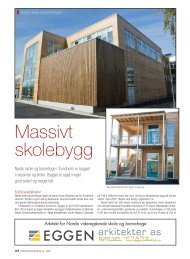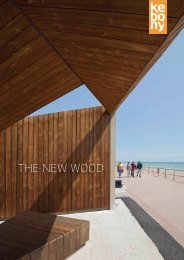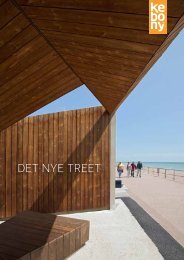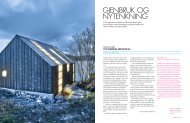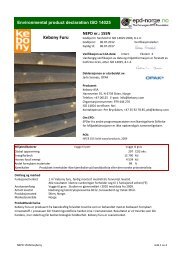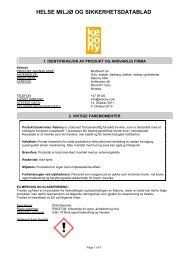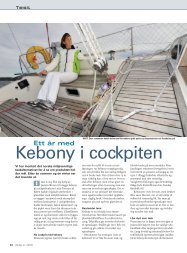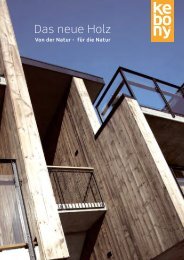Most systems can be retrofitted when upgrading The iconic ... - Kebony
Most systems can be retrofitted when upgrading The iconic ... - Kebony
Most systems can be retrofitted when upgrading The iconic ... - Kebony
- No tags were found...
You also want an ePaper? Increase the reach of your titles
YUMPU automatically turns print PDFs into web optimized ePapers that Google loves.
oatsA Contessa 32for our times<strong>The</strong> <strong>iconic</strong> Contessa 32 is <strong>be</strong>ing re-built for the 21st century by heroriginator, Jeremy Rogers. His daughter-in-law Jessie explainshow this new Contessa is jam-packed with green innovation<strong>The</strong> Contessa 32 is a‘grande dame’ of thesailing world, one of thefew fibreglass boatsconsidered a classic.Jeremy Rogers has built them sincethe 1970s, and new 32s still roll outof his yard in Lymington YachtHaven while many more arerefurbished to their former glory.One famous restoration was of hisown boat, the legendary Gigi (seePBO June 2008), a 30-year-old boatwith a lifetime of stories. She wascarefully restored over three yearsand went on to win the Contessa 32<strong>The</strong> new, greener Contessa 32 will<strong>be</strong> outwardly similar to the existingclass yachtsNational Championships twice withJeremy at the helm.Gigi was sold last summer, but it<strong>be</strong>came clear that Jeremy and myhusband Kit were plotting. <strong>The</strong>ywanted to build a new boattogether which could <strong>be</strong> used as atest <strong>be</strong>d for some of the new ‘eco’technologies and products – still inclass, but a prototype for a futuregeneration of greener Contessa32s. She would <strong>be</strong> called Calypso,partly after the daughter of Atlas,the mythological Greek deity whobore the world on his shoulders –which seems fitting for a boat tryingto reduce its impact on theenvironment – and also to honourthe Calypso of Jacques Cousteau,who inspired so many would-<strong>be</strong>marine scientists, including Kit.In a previous life, Kit wasskipper of a sailing whaleresearch yacht and then,together, we had our own sailingboat as a filming platform for theBBC during the making of the BluePlanet series. Once we had childrenKit decided to take a job as ascience teacher in the localsecondary school, but you don’tget boats out of your system thateasily: building our own greenerversion of a Contessa 32 would, Kitargued, <strong>be</strong> the perfect opportunityto marry his passions for both boatsand the environment. He wouldwork alongside Jeremy onweekends and in the holidays.Is glassfibre still fit?We needed a pragmatic approachto greening the Contessa 32: what<strong>can</strong> <strong>be</strong> done on the averageglassfibre boat to reduce theimpact on the environment?Before going any further I’llacknowledge that glassfibre boatsdon’t have a great reputation for<strong>be</strong>ing the ‘eco option’. <strong>The</strong>re is ahemp alternative, and a plant-basedresin which could replace thetraditional petrochemical resins, butwe didn’t feel quite confidentenough in the products to risk<strong>Most</strong> <strong>systems</strong> <strong>can</strong> <strong>be</strong><strong>retrofitted</strong> <strong>when</strong> <strong>upgrading</strong>compromising the integrity of thehull, at least not in the Mk1 version.Although not an option for aContessa 32 if we were going tokeep the boat in class, we alsolooked into aluminium, oftenchampioned as the environmentalchoice <strong>be</strong>cause of its recyclablequalities. Jeremy argues that if youbuild a quality glassfibre boat out ofsolid glassfibre and resin (ie with nocore material to compromise thelong-term integrity) it could <strong>be</strong>argued that GRP does stand upagainst aluminium as an ecooption,<strong>be</strong>cause the boat shouldlast for many generations ifmaintained properly. It’s 40 yearssince the first Contessa 32s wererolled out of the factory inLymington and those boats are stillgoing strong, so although there isno point trying to pretend thatglassfibre is a great environmentalchoice for all boats, in this case it’sa pretty good one.Install it yourself<strong>Most</strong> of the <strong>systems</strong> we are fitting tothe boat <strong>can</strong> <strong>be</strong> <strong>retrofitted</strong> by otherboat owners <strong>when</strong> <strong>upgrading</strong> orrenewing <strong>systems</strong> or duringthe course of routinemaintenance, so hull andaluminium mast aside (weare currently talking to mastmanufacturer Seldén aboutrecycled aluminium) what <strong>can</strong> <strong>be</strong>done to improve on the standardfare on offer to boaters?Which wood?<strong>The</strong> use of teak has always <strong>be</strong>en aworry as finding a truly sustainablesource <strong>be</strong>comes ever moreproblematic. Research revealed aNorwegian company who seem tohave cracked it with a product38 Practical Boat Owner 524 Summer 2010 • www.pbo.co.uk
New green Contessa 32Kit (left) and Jeremy Rogers atwork on Calypso, the new moreeco-friendly Contessa 32called <strong>Kebony</strong>. This material ismade <strong>when</strong> managed softwoods (inour case maple) are treated using aclever process involving furfurylalcohol, a waste product from theprocessing of sugar<strong>can</strong>e. <strong>The</strong> woodis placed in a vat of furfuryl alcohol,which is forced in under pressureand then heated to 110°C totransform the liquid into a resin. Thiseffectively turns a softwood veryquickly into a hardwood by makingthe cell walls thicker and stronger.<strong>Kebony</strong> should weather like teakand <strong>can</strong> also <strong>be</strong> disposed of asuntreated wood, as the process is anatural one and contains no toxinsthat <strong>can</strong> leach out into the soil orwatercourses. So far Jeremy ispleased with the way the woodworks and feels, so it’s now just aquestion of waiting and seeing howit fares over the years in a marineenvironment.Powering downAnother big debate around theRogers kitchen table has <strong>be</strong>enwhether to go for a hybrid engine.Initially the idea was dismissed, aswe understood that in order togenerate electricity we would needa large fixed propeller – somethingno Rogers in their right mind wouldsign up to as the drag from aconstantly spinning prop wouldmake the boat uncompetitive. <strong>The</strong>nGraeme Hawksley from HybridMarine (the hybrid arm ofBetamarine) explained his solution.A feathering prop <strong>can</strong> <strong>be</strong> trickedinto a generating position bykicking it into reverse – meaning we<strong>can</strong> feather in light winds and <strong>when</strong>left <strong>Kebony</strong> replaces teak, mahoganyand other traditional hardwoodsGreen featuresn <strong>Kebony</strong> – an alternative to rain forest hardwoods inwhich a chemical process is used to infuse ordinarysoftwoods with a naturally-occurring resin, transformingthe softwood into a much harder and longer-lastingwood productn Hybrid engine – a diesel-electric system which <strong>can</strong>use either the diesel engine or electric motor for propulsion.<strong>The</strong> electric motor also doubles as a generator – puttingpower back into the boat’s large battery bank undersail via a clever feathering/backwards-spinning propn Solar panels and wind turbines – thesewill <strong>be</strong> integrated with the hybrid engine systemfeeding in to a much larger than normal battery bankn Batteries – the new generation of lithium-ionbatteries is an option, offering longer life and storagein a much more compact unitn LED lighting – low power consumption from lightsleaves more battery power for other electrical devicesn Rubbish bins – allocating extra space forrecycling and rubbish aboard means less landfill <strong>when</strong>you get ashoreracing – and generate <strong>when</strong> there isplenty of wind. Hybrid engines arestill rare in sailing boats, andpropeller manufacturers DarglowMarine are keen to use Calypso asa test <strong>be</strong>d to work on maximizingperformance for both generatingand propulsion.Of course, we <strong>can</strong> resort to thediesel engine, or shore power <strong>when</strong>in a marina, but we’d like toexperiment with just how self-reliantwe <strong>can</strong> <strong>be</strong>. Wind turbines and solarpanels will <strong>be</strong> fitted and integratedwith the hybrid system, feedingeither into what will <strong>be</strong> a ratheroversized battery bank for aContessa 32 or, possibly, into themore compact option of the newgeneration of lithium-ion batteries.Choosing a hybrid engine opensup a whole raft of other possibilities– using electricity instead of gas forcooking, a super efficient electricfridge, possibly even a microwaveoven! Recent advancements intechnology mean there’s so muchmore potential in the battery bank.Lighting will <strong>be</strong> LED, as willnavigation lights. <strong>Most</strong> companieswhose products use electricity, frombilge pump manufacturers toelectronics giants and fridgedesigners to windlassmanufacturers, have made bigimprovements on efficiency. We’lluse these products, as every jouleof energy will need to <strong>be</strong> accountedfor if we are to avoid resorting to thediesel engine or shore power.during an early morning swim offthe back of the boat!), but holdingtanks are still a difficult andexpensive option. Our plan is to fitCalypso with a tank that <strong>can</strong> <strong>be</strong>pumped out where the facilitiesallow, but also allows us theflexibility to pump out for ourselvesif far enough offshore.Another issue... how many of usreligiously separate our recyclablewaste at home and then throweverything in the same bin <strong>when</strong> ona sailing trip? Part of the problem isthe rubbish facilities (pun intended)offered at many of the marinas andshore facilities, but it’s also down tolack of waste storage and separationon the boat itself – something we areaddressing on Calypso.Like all good projects, Calypsoevolves. We’re still researchingvarnish and oils, antifouling<strong>systems</strong>, sails and upholsteryoptions, electronics and cleaningproducts. By the time she reachesthe Southampton Boat Show shewill no doubt <strong>be</strong> a different boat tothe one we first dreamed of. But wehope that by the time she’s finishedAtlas will <strong>be</strong> proud of her.n Contessa 32 Calypso,sponsored by the RYA GreenBlue, will <strong>be</strong> on display at theSouthampton Boat Show,showcasing innovations fromhybrid engines to holdingtanks, teak substitutes andwind turbines.<strong>The</strong> Contessa 32 hull moulds have <strong>be</strong>en back in action in the Jeremy Rogersworkshop to create a new-generation eco-friendly 32Waste notUnlike many other countries, theUK is still fairly relaxed about boatspumping out effluent into marinasand rivers (not a happy thoughtNEXT TIMECalypso nears completionready for her SouthamptonBoat Show debutPractical Boat Owner 524 Summer 2010 • www.pbo.co.uk 39


